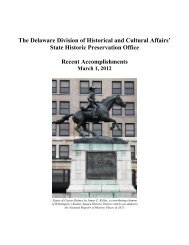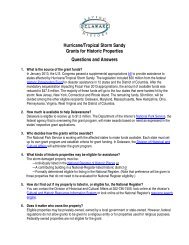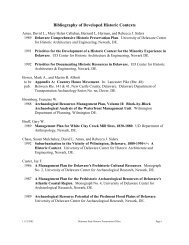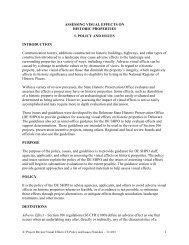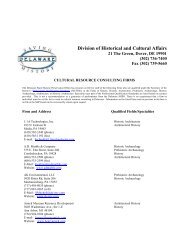Report of the Archaeological Investigations of the New Castle Court ...
Report of the Archaeological Investigations of the New Castle Court ...
Report of the Archaeological Investigations of the New Castle Court ...
You also want an ePaper? Increase the reach of your titles
YUMPU automatically turns print PDFs into web optimized ePapers that Google loves.
NEW CASTLE COURT HOUSE PLAZA<br />
NEW CASTLE, DELAWARE<br />
3.0 FIELD RESULTS<br />
truncated by an erosion feature (Feature 37) since no additional units were excavated east <strong>of</strong> this<br />
point. However, <strong>the</strong> fact that this apparent end point aligns perpendicularly with Feature 39, a<br />
north-south orientated palisade trench, does help support <strong>the</strong> notion that this may be <strong>the</strong><br />
sou<strong>the</strong>astern corner <strong>of</strong> <strong>the</strong> fortification defense. The intact western edge is also interesting, not<br />
only because <strong>the</strong> feature appears to stop at <strong>the</strong> north-south trending brick wall (Feature 58), but<br />
also because <strong>the</strong> trench appears to turn slightly to <strong>the</strong> south (Plate 14). The directional shift is also<br />
apparent within <strong>the</strong> nor<strong>the</strong>rn palisade trench (Features 27 and 45). This feature was sectioned<br />
within EU 4 and within EUs 15/16 and <strong>the</strong> only recovered artifacts originated from surface<br />
cleanup. In addition to brick fragments, <strong>the</strong> o<strong>the</strong>r collected artifacts consisted <strong>of</strong> a redware<br />
fragment and a tin glazed ear<strong>the</strong>nware sherd. The portion <strong>of</strong> <strong>the</strong> feature matrix excavated did not<br />
contain any additional artifacts. The pr<strong>of</strong>ile indicates that <strong>the</strong> trench was square cut, having an<br />
approximate depth <strong>of</strong> 2.40 ft. on <strong>the</strong> west and 1.32 ft. on <strong>the</strong> east plaza sections; <strong>the</strong>se depths are<br />
measured from <strong>the</strong> top <strong>of</strong> <strong>the</strong> intact subsoil.<br />
At <strong>the</strong> base <strong>of</strong> <strong>the</strong> trench in EU 4, post mold impressions in <strong>the</strong> shape <strong>of</strong> split-logs were in<br />
evidence, while similar stains were noted within <strong>the</strong> sectioned portion on <strong>the</strong> west plaza. The<br />
stains at <strong>the</strong> base <strong>of</strong> <strong>the</strong> EU 4 portion were bisected, but yielded no additional artifacts and <strong>the</strong><br />
section within EUs 15 and 16 were identified approximately half way through <strong>the</strong> excavation <strong>of</strong><br />
<strong>the</strong> western section. Once identified, each mold received an independent feature designation from<br />
east to west (corresponding to 40 through 44). Features 40 through 42 were bisected and fully<br />
excavated to show that <strong>the</strong> post molds were indeed semi-circular in plan and tapering slightly<br />
toward <strong>the</strong> base (Plate 15). No artifacts were recovered from <strong>the</strong> excavation <strong>of</strong> <strong>the</strong>se mold<br />
impressions.<br />
Features 27 and 45<br />
Features 27 and 45 were assigned to <strong>the</strong> nor<strong>the</strong>rn palisade trench identified separately on <strong>the</strong><br />
eastern and western plaza sections. This palisade line appears to be <strong>the</strong> nor<strong>the</strong>rn counterpart to<br />
Features 24 and 29. Its total length was 67.5 ft., or 6 ft. shorter than <strong>the</strong> sou<strong>the</strong>rn trench line with<br />
its eastern terminus identified within EU 24 on <strong>the</strong> east plaza; adjacent <strong>the</strong> eastern edge are two<br />
brick molds identified within <strong>the</strong> subsoil. The western edge <strong>of</strong> this feature also appeared to<br />
change orientation toward <strong>the</strong> southwest and appeared to terminate at <strong>the</strong> north-south orientated<br />
brick wall (Feature 58) on <strong>the</strong> west plaza.<br />
Feature 39<br />
Feature 39 is a north/south orientated trench that was identified at <strong>the</strong> top <strong>of</strong> <strong>the</strong> subsoil within<br />
EUs 9 and 23 (Plate 19). It extends from <strong>the</strong> nor<strong>the</strong>rn edge <strong>of</strong> EU 23 and terminates north <strong>of</strong><br />
Feature 37, a drainage feature in EU 23, for an overall feature dimension <strong>of</strong> 6.7 by 1.9 ft. Post<br />
mold impressions were documented along <strong>the</strong> eastern edge <strong>of</strong> <strong>the</strong> trench, similar to previously<br />
observed mold stains in <strong>the</strong> o<strong>the</strong>r palisade lines. This feature may comprise <strong>the</strong> eastern side <strong>of</strong> <strong>the</strong><br />
fortification line.<br />
3.5.9 PLAZA CONSTRUCTION AND MISCELLANEOUS FEATURES<br />
Feature 19<br />
Feature 19 comprised <strong>the</strong> lowest fill layer present within <strong>the</strong> eastern plaza and was assigned a<br />
feature number when initially identified in EU 6. A total <strong>of</strong> 2111 artifacts were recovered from<br />
sampled portions in EUs 6 through 9 and 23 through 28. Please refer to <strong>the</strong> field results section<br />
for fur<strong>the</strong>r discussion.<br />
48





